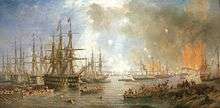James Wilson Carmichael

James Wilson Carmichael (9 June 1800 – 1868), also known as John Carmichael was an English marine painter.
Life
Carmichael was born at the Ouseburn, in Newcastle upon Tyne, Northumberland, on 9 June 1800, the son of William Carmichael, a ship's carpenter. He went to sea at an early age, and spent three years on board a vessel sailing between ports in Spain and Portugal. On his return, he was apprenticed to a shipbuilding firm.[1] After completing his apprenticeship, he devoted all his spare time to art, and eventually gave up the carpentry business, setting himself up as a drawing-master and miniature painter. His first historical painting to attract public notice was the Fight Between the Shannon and Chesapeake, which sold for 13 guineas (£13.65). He then painted The Bombardment of Algiers for Trinity House, Newcastle, for which he received 40 guineas;[2] it is still at Trinity House, along with The Heroic Exploits of Admiral Lord Collingwood in HMS "Excellent" at the Battle of Cape St. Vincent, painted in collaboration with George Balmer.[3] Another important early commission was for a View of Newcastle for which the city corporation paid him 100 guineas.[2]
His name first appears as an exhibitor in 1838, when he contributed an oil painting, Shipping in the Bay of Naples, to the Society of British Artists. He showed both oil paintings and watercolours at the Royal Academy, his contributions including The Conqueror towing the Africa off the Shoals of Trafalgar (1841) and The Arrival of the Royal Squadron (1843).[4]
He lived in Newcastle until about 1845, when he moved to London, where he was already known as a skilful marine painter.[4] In 1855, during the Crimean War he was sent to the Baltic to make drawings for The Illustrated London News. His painting of the bombardment of Sveaborg, which he witnessed during this assignment, was exhibited at the Royal Academy and is now in the collection of the National Maritime Museum.[5][6]
He later moved to Scarborough, where he died in 1868.[4]
He published The Art of Marine Painting in Water-Colours in 1859, and The Art of Marine Painting in Oil-Colours in 1864.[7]
His daughter Annie married William Luson Thomas son of a shipbroker and a successful artist who, exasperated by the treatment of artists by The Illustrated London News, founded in 1869 The Graphic newspaper which had immense influence within the art world.
 Cullercoats from the South, 1845, private collection
Cullercoats from the South, 1845, private collection
 The Irwin Lighthouse, Storm Raging, 1851, private collection
The Irwin Lighthouse, Storm Raging, 1851, private collection The Bombardment of Sveaborg, 9 August 1855, 1855, now at the National Maritime Museum
The Bombardment of Sveaborg, 9 August 1855, 1855, now at the National Maritime Museum Off the Dutch Coast, 1858, now at the Willow Gallery, London
Off the Dutch Coast, 1858, now at the Willow Gallery, London
References
- ↑ http://www.thejournal.co.uk/north-east-analysis/analysis-news/fine-art-featuring-storm-tossed-7943251
- 1 2 Mackenzie, Eneas (1827). A Descriptive and Historical Account of the Town and County of Newcastle. Newcastle upon Tyne: Mackenzie and Dent. p. 581.
- ↑ "Historic Buildings". Trinity House. Retrieved 30 January 2014.
- 1 2 3 Bryan,1886-9
- ↑ Lambert, Andrew (2011). The Crimean War: British Grand Strategy Against Russia, 1853-56. London: Ashgate Publishing. pp. 24 5. ISBN 9781409410126.
- ↑ "The Bombardment of Sveaborg, 9 August 1855". Royal Museums Greenwich. Retrieved 31 January 2014.
- ↑ http://spartacus-educational.com/Jcarmichael.htm
Sources
This article incorporates text from the article "CARMICHAEL, James Wilson" in Bryan's Dictionary of Painters and Engravers by Michael Bryan, edited by Robert Edmund Graves and Sir Walter Armstrong, an 1886–1889 publication now in the public domain.
External links
| Wikimedia Commons has media related to John Carmichael. |
- Works by or about James Wilson Carmichael at Internet Archive
- Biography from the National Maritime Museum